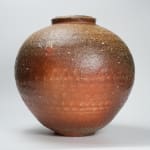Kohara Yasuhiro 小原康裕 Japanese, b. 1954
Large Shigaraki Jar, 2025
Stoneware
H6 7/8 × Dia 6 3/4 in.
H17.5 × Dia 17 cm
H17.5 × Dia 17 cm
Signed at the base by the artist, No box
Sold
Further images
-
(View a larger image of thumbnail 1
)

-
(View a larger image of thumbnail 2
)

-
(View a larger image of thumbnail 3
)

-
(View a larger image of thumbnail 4
)

-
(View a larger image of thumbnail 5
)

-
(View a larger image of thumbnail 6
)

-
(View a larger image of thumbnail 7
)

-
(View a larger image of thumbnail 8
)

-
(View a larger image of thumbnail 9
)

-
(View a larger image of thumbnail 10
)

Kohara Yasuhiro (b. 1954) creates works born of ash, wood, fire, and earth, blending a contemporary sensibility with the deep-rooted traditions of Shigaraki clay. His mastery of ash glaze brings...
Kohara Yasuhiro (b. 1954) creates works born of ash, wood, fire, and earth, blending a contemporary sensibility with the deep-rooted traditions of Shigaraki clay. His mastery of ash glaze brings a sense of abstraction, setting his pieces apart within the Shigaraki tradition. By harnessing kiln effects alongside the glaze, he achieves surfaces of remarkable depth and complexity, ensuring that the story of Shigaraki continues to resonate. This jar is inspired by the forms of Moon jars from the Joseon dynasty and the traditional Korean hand-building technique known as Onggi. This method involves an intricate slab construction and hand-patting process, which demands a deep understanding of the clay’s properties.
The piece is distinctly Kohara Yasuhiro’s own. Hand-built with visible impressions of his hands pressed into the clay, its textured surface lies beneath a flowing olive-green ash glaze, offering a tactile, variegated surface. The glaze drips diagonally across the form, introducing movement and tension. This piece not only reflects the influence of Korean ceramics but also demonstrates the technical precision required to merge surface composition with the raw power of yakishime pottery.
The piece is distinctly Kohara Yasuhiro’s own. Hand-built with visible impressions of his hands pressed into the clay, its textured surface lies beneath a flowing olive-green ash glaze, offering a tactile, variegated surface. The glaze drips diagonally across the form, introducing movement and tension. This piece not only reflects the influence of Korean ceramics but also demonstrates the technical precision required to merge surface composition with the raw power of yakishime pottery.
75
of
75









